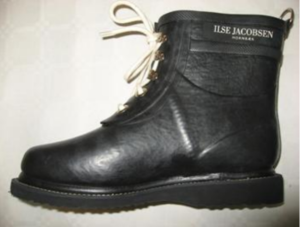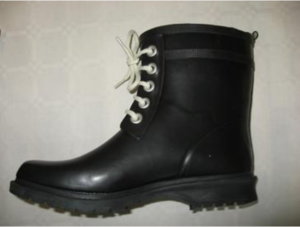This blog will explore potential disadvantages of failing to utilise the registered community design (hereafter RCD) in a Danish context with a particular emphasis on cheap imitations of luxury consumer goods. The point of reference will be a November 2016 case from the Danish Maritime and Commercial High Court (the “Court”) concerning rubber boots made by Danish designer Ilse Jacobsen and allegedly infringing copies thereof.
The exclusive Ilse Jacobsen rubber boot, named RUB 2, sold at a retail price of DKK 900 (roughly €120). It was allegedly infringed by the ‘DS’ boot sold by the largest retail operation in Denmark, Dansk Supermarked, for DKK 99 (less than €15). Both were short, laced and incorporated a diamond patterned band at the edge of the boot. They were set apart by the sole, the lining and the extent of the diamond patterned band as well as the rubber material from which they were made. The latter contributed to giving the RUB 2 a matt finish.
The boots are pictured below with the RUB 2 on the left and the DS boot on the right.
The RUB2 was not registered as an RCD. Nor was the designer able to argue that it should be protected as an unregistered community design due to its 2004 introduction – approximately 10 years before the launch of the DS boot. Instead protection had to be sought under either the copyright regime or the Danish Marketing Practises Act’s (the “MPA”) ban on product imitations. With the court denying copyright protection, the designer was left to rely on the protection of the MPA which offers protection against product imitations similar to the UK doctrine of passing off.
The MPA offers supplementary protection against product imitations. The ban is derived from section 1 of the act which merely states that all traders “[…] shall exercise good marketing practice”. This highly flexible provision is one of the most widely used in all types of infringement cases.
The subject of protection under the MPA is the market position of the original product. Thus, Dansk Supermarked argued that due to the different price segments of the RUB 2 and the DS boot, the two types of boots were not in competition and consequently the DS boot did not affect the market position of the RUB 2. This argument would, of course, not affect a design law case with the RCD not being industry-specific, and certainly not limited to certain price segments within an industry. However, under the MPA the court ruled in favour of Dansk Supermarked on this point.
The scope of protection offered by EU Design Regulation stands in contrast to the protection offered by the MPA, which will often only offer protection against very close imitations. This point was also stressed by the Court in this particular case when they ruled that such similarity was not present, thus confirming that a high degree of similarity must be present under the MPA.
In the present case the infringement assessment was based on physical examples of the boots. This created challenges for the RUB 2 boot, as the material from which it was manufactured created a different impression from the leather boot. This difference in materials may not have been such an issue had the assessment been made on the basis of the graphical representation of a registered design.
Although the court did not rule on this particular issue in light of the above, the MPA requires the resemblance of the products to be a result of both the knowledge of the earlier product and a disloyal aim to copy the earlier product, i.e. a subjective element requiring bad faith on the part of the infringer.
On the basis of the above, the Court found the RUB 2 to be protected under the MPA, however, the DS boot did not infringe due to the lack similarity and lack of direct competition.
Of course, one can only speculate as to the outcome of the case if RUB 2 was protected as an RCD. However, it remains clear that by relying solely on the MPA the designer must be prepared to deal with issues such as different price segments and choice of material which would not have merit in a case concerning infringement of an RCD. Consequently, the RCD grants the designer with both a broader scope of protection as well as extending the protection to situations where the infringing products are sold at a low price.
_____________________________
To make sure you do not miss out on regular updates from the Kluwer Trademark Blog, please subscribe here.




